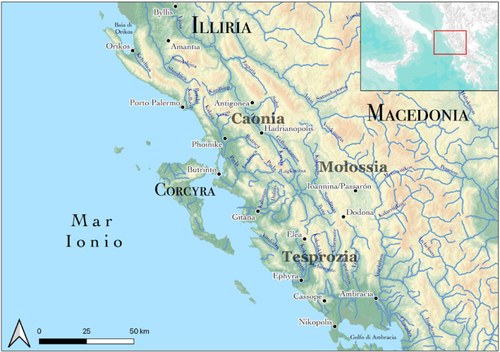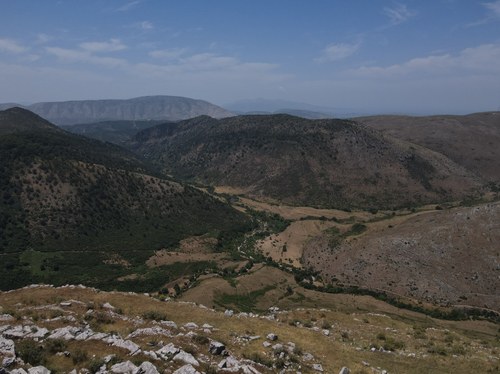
Chaonia (in ancient Greek Χαονία) corresponds to the northern part of ancient Epirus and it is almost entirely comprised within the modern Albanian territory, in the present-day administrative districts (qarku) of Vlorë and Gjirokastër. As in the case of many ancient geographical regions, the boundaries of Chaonia can not be clearly defined and it is likely that they slightly changed over the time. However, natural borders could be considered the Ionian sea to the west, the Acroceraunian mountains and the ridge of Mali i Gribës to the north, the course of the Vjosë river to the north-east, and the course of the Kalamas river to the east/south-east. Consequently, Chaonia can be divided in three main sectors: the area along the Ionian shore where the coastal plains are located, the piedemont area at the foot of the northern mountain ranges, and the Drino valley in the inland to the east.
Map of ancient Epirus from Carbotti F., D'Ambola F., Rivoli M., Sigismondo G., Paesaggi d'Epiro. Studi di archeologia del paesaggio in Albania meridionale, 2024, Bologna: Bologna University Press, page 8.

The available archaeological data show the development of a dense settlement pattern starting from the Late Bronze age and probably continuing at the beginning of the first millennium BC. This phenomenon is better known for other parts of Epirus such as Thesprotia, where it has been related to the maritime trade routes between the East and the West of the Mediterranean basin. Such a key-role of Epirus as a border region seemingly persisted during the Greek Archaic period, when new settlements arose in the Ionian and in the Adriatic area, even if the relationship between the apoikiai and the Epirote coastal region, such as Chaonia, is not easy to understand from the archaeological perspective. Chaonians are mentioned by Thucydides in the 5th century BC as one of the main and most powerful Epirote tribes and between the 4th and the 3rd centuries BC they were involved in the complex process which led to the birth of the Epirote state, first under the Molossian monarchy and then through the transformation into a confederation (231-167 BC). In this period the main regional ancient centres, such as Phoinike, Antigonea, Butrint, and Kestría, flourished. The Roman intervention in the Balkans altered the political stability of the young state, stressing the divisions between the tribes: progressively, Chaonians moved their political stance closer to the Roman part. This attitude kept the region safer from the destruction that hit the Greek world but caused the end of the independence as well as the integration in the new framework established by the winner’s power. After the Roman civil wars and the creation of the principate by Augustus, during the imperial period the region took advantage of its position along the coast and on the terrestrial routes, as it emerges from the main cities of Butrint, Phoinike and Hadrianopolis. The provincial unity and the strong interconnection, ratified by the creation of the province of Epirus in the 2nd century AD, underwent drastic changes in the following centuries: the lack of a strong central power, the migration of peoples coming from the North, and the numerous conflicts shaped a more shattered picture, which substantially regarded ancient Epirus as a whole and lasted until Modern times.
The most important cities were not abandoned but they followed different dynamics of transformation related to specific contexts. However, the reduction of urban size, the ruralisation of structures and the metamorphosis functional to the needs brought by the advent of Christianity are typical of the late-antique period in Chaonia. Until the 7th century it seems to be still integrated in the Mediterranean network of trade, progressively loosing ties with the West to the advantage of the East Greek-Byzantine world.
The Ottoman conquest of the region and the attempt to create a modern “Epirote state” by Ali Pasha of Tepelenë offered a taste of the processes leading to the formation of the Greek and the Albanian state, opening the season of the nationalism whose ill-fated consequences have only recently begun to be overcome